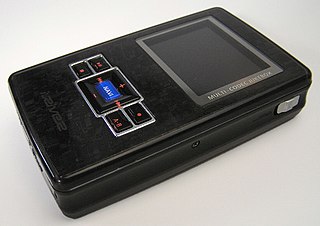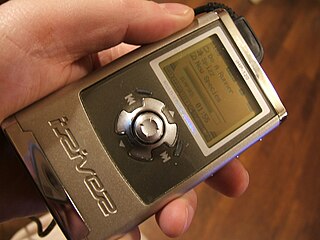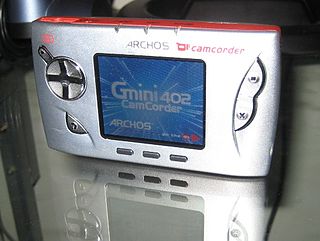
A flash drive is a data storage device that includes flash memory with an integrated USB interface. A typical USB drive is removable, rewritable, and smaller than an optical disc, and usually weighs less than 30 g (1 oz). Since first offered for sale in late 2000, the storage capacities of USB drives range from 8 megabytes to 256 gigabytes (GB), 512 GB and 1 terabyte (TB). As of 2023, 2 TB flash drives were the largest currently in production. Some allow up to 100,000 write/erase cycles, depending on the exact type of memory chip used, and are thought to physically last between 10 and 100 years under normal circumstances.
The Nomad was a range of digital audio players designed and sold by Creative Technology Limited, and later discontinued in 2004. Subsequent players now fall exclusively under the MuVo and ZEN brands.

The USB mass storage device class is a set of computing communications protocols, specifically a USB Device Class, defined by the USB Implementers Forum that makes a USB device accessible to a host computing device and enables file transfers between the host and the USB device. To a host, the USB device acts as an external hard drive; the protocol set interfaces with a number of storage devices.

ZEN is a series of portable media players designed and manufactured by Creative Technology Limited from 2004 to 2011. The players evolved from the NOMAD brand through the NOMAD Jukebox series of music players, with the first separate "ZEN" branded models released in 2004. The last Creative Zen player, X-Fi3, was released at the end of 2011.

The Dell Digital Jukebox or just Dell DJ is a brand name for a series of digital audio players sold by the Dell corporation.

A portable media player (PMP) or digital audio player (DAP) is a portable consumer electronics device capable of storing and playing digital media such as audio, images, and video files. The data is typically stored on a compact disc (CD), Digital Versatile Disc (DVD), Blu-ray Disc (BD), flash memory, microdrive, SD cards or hard disk drive; most earlier PMPs used physical media, but modern players mostly use flash memory. In contrast, analogue portable audio players play music from non-digital media that use analogue media, such as cassette tapes or vinyl records.

The Rio Carbon is a line of digital audio players that was produced by the now defunct Rio from 2004 to 2005. It was similar in size, capacity, and cost with Apple's iPod Mini which debuted earlier the same year. This was Rio's second player to use a miniature hard disk for storage, after the Rio Nitrus, which was first to market with a 1.5 GB drive in late 2003.

The iRiver H300 series are a series of portable audio players developed by iRiver, made up of the iRiver H320 and H340 models. They were first announced on September 22, 2004 replacing the H100/iHP-100. Each can play music, transfer pictures directly from digital cameras and UMS-compatible devices, such as flash drives, and display digital images on a colour screen. In the United States, the H320 initially retailed for $329 and the H340 was $429.

The iRiver H100 series is a series of discontinued portable digital audio players (DAP) made by iriver and originally released in October 2003. The models in the H100 series differ mainly in hard drive storage capacity. The players were succeeded by the iriver H300 series.

iAUDIO is the brand name for a range of portable media players produced by Korean consumer electronics and software corporation Cowon Systems, Inc.

Lyra is a series of MP3 and portable media players (PMP). Initially it was developed and sold by Indianapolis-based Thomson Consumer Electronics Inc., a part of Thomson Multimedia, from 1999 under its RCA brand in the United States and under the Thomson brand in Europe. There were also RCA/Thomson PMPs without the Lyra name, such as the RCA Kazoo (RD1000), RCA Opal and RCA Perl. In January 2008, Thomson sold its Consumer Electronics part including the RCA brand and Lyra line to AudioVox. RCA-branded PMPs are still being made today in its domestic market but no longer under the Lyra name. The Lyra was an early pioneer in digital audio players, although in later years most of its output were OEM products.

Yepp was Samsung Electronics' digital audio player brand until Samsung decided to retire most of their family brands in February 2011. From then on, their MP3 players were simply branded "Samsung" worldwide until they discontinued all of them in late 2013. The brand included a wide range of hard-drive based as well as flash-memory based players. The name is claimed to be an acronym for "young, energetic, passionate person".

The RioForge is a digital audio player that was produced by Rio Audio, Inc. While it competed in the same market as Apple Inc's iPod mini, it is considerably different as it plays from internal memory, SD card, or FM broadcast and runs on a single AAA battery.

SanDisk has produced a number of flash memory-based digital audio and portable media players since 2005. The current range of products bears the SanDisk Clip name. SanDisk players were formerly marketed under the Sansa name until 2014.

The Gmini is a series of portable audio and video players released by Archos in 2004 and 2005.

The Archos AV series is a line of portable media players from the company called Archos that was released through 2003 to 2005. This series introduced the digital video recorder for the AV500, an optional feature that would be compatible in subsequent players. Although the AV series did not have standalone digital audio players, Archos did release them under the concurrently released Gmini series.

The Archos Jukebox is a series of Archos portable audio players from 2000 to 2002.

The Sansa Fuze is a portable media player developed by SanDisk and released on March 8, 2008. The Fuze is available in three different Flash memory capacities: 2 GB, 4 GB, and 8 GB and comes in six different colors: black, blue, pink, red, silver, and white. Storage is expandable via a microSDHC slot with capacity up to 32 GB, and unofficially to 64 GB or more via FAT32 formatted SDXC cards. All models have a 1.9 inch TFT LCD display with a resolution of 220 by 176 pixels and a built-in monaural microphone and FM tuner; recordings of the latter two are saved as PCM WAV files.
The French consumer electronics company Archos manufactured a number of products which have since been discontinued.
The following is a list of software used in the Personal Jukebox. It includes computer-based software, as well as device software

















